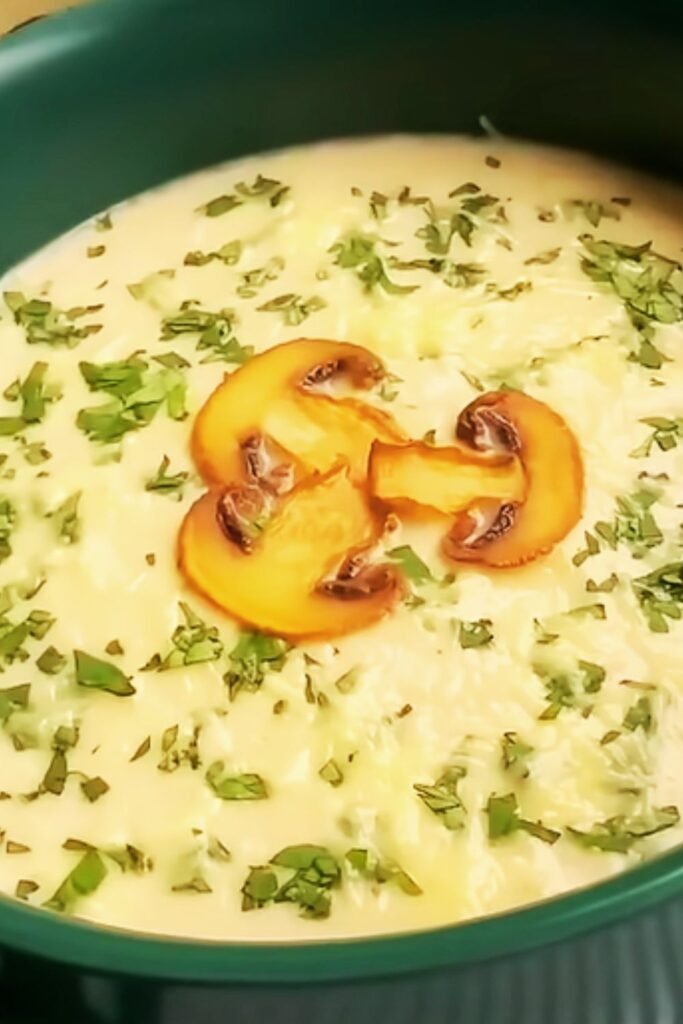There’s something magically comforting about a bowl of creamy soup that warms you from the inside out. As someone who has spent countless hours perfecting soup recipes in my home kitchen, I can confidently say that this Leek, Mushroom and Rice Creamy Soup is one of my proudest creations. It strikes the perfect balance between hearty and refined, with earthy mushrooms, sweet leeks, and tender rice swimming in a velvety broth that feels like a warm hug on a cold day.
What makes this soup special isn’t just its incredible flavor profile, but also its versatility. I’ve served it as an elegant starter for dinner parties and as a complete meal on busy weeknights. The combination of leeks and mushrooms creates a deeply savory foundation, while the rice adds a satisfying texture that makes this soup substantial enough to be a main course.
So grab your favorite soup pot and join me as I walk you through creating this soul-warming dish that has become a staple in my home and will surely become one in yours too.
The Magic of Leeks, Mushrooms, and Rice Together
Before diving into the recipe, let me share why these three ingredients create such harmony in a soup.
Leeks belong to the allium family alongside onions and garlic, but offer a more delicate, sweeter flavor that adds complexity without overpowering other ingredients. When slowly sautéed, they develop a buttery softness and release natural sugars that form the backbone of our soup’s flavor.
Mushrooms bring an unmistakable umami depth that few other vegetables can match. I love how they contribute a meaty texture without actually containing any meat, making this soup satisfying for both omnivores and vegetarians alike. The variety of mushrooms you choose can dramatically change the soup’s character—from earthy cremini to delicate shiitake or robust portobello.
Rice serves multiple purposes in this soup. Beyond adding heartiness, it releases starch as it cooks, naturally thickening the broth without requiring excessive cream or flour. I prefer medium-grain rice for this recipe as it strikes the perfect balance between maintaining its structure and creating that coveted creaminess.
Ingredients You’ll Need
For a soup that serves 6 people generously:
- 3 large leeks (white and light green parts only)
- 500g mixed mushrooms (I like a combination of cremini, shiitake, and white button)
- 1 cup medium-grain rice (Arborio or Carnaroli work beautifully)
- 2 tablespoons olive oil
- 2 tablespoons butter
- 4 cloves garlic, minced
- 1 teaspoon fresh thyme leaves (or 1/2 teaspoon dried)
- 1 bay leaf
- 6 cups vegetable stock (homemade if possible)
- 1 cup heavy cream
- Salt and freshly ground black pepper to taste
- 2 tablespoons fresh parsley, chopped (for garnish)
- 1/4 cup grated Parmesan cheese (optional but recommended)
- 1 tablespoon lemon juice (adds brightness at the end)
Special Equipment
- Large, heavy-bottomed soup pot or Dutch oven
- Sharp knife for slicing leeks and mushrooms
- Wooden spoon for stirring
- Ladle for serving
Preparing Your Ingredients

Cleaning and Preparing Leeks
Leeks are notorious for hiding dirt between their layers, so proper cleaning is essential:
- Trim off the dark green tops and the root ends.
- Slice the leeks in half lengthwise.
- Fan the layers under cool running water to remove any sand or dirt.
- Slice the cleaned leeks into thin half-moons (about 1/4 inch thick).
I’ve learned through countless meals that taking the time to clean leeks thoroughly makes all the difference—there’s nothing worse than the unpleasant crunch of sand in an otherwise perfect soup!
Mushroom Preparation
The way you cut your mushrooms affects both the texture and cooking time:
- Clean mushrooms by gently wiping with a damp paper towel or using a mushroom brush. Avoid soaking them as they absorb water like sponges.
- Remove any tough stems, particularly from shiitakes if you’re using them.
- Slice most mushrooms about 1/4 inch thick, but consider leaving some smaller ones halved or quartered for textural variety.
I love creating different sizes and shapes when cutting mushrooms—it adds visual interest and ensures varied texture in each bite.
Rice Considerations
Unlike most rice dishes, there’s no need to rinse the rice for this soup. The surface starch contributes to the creamy texture we’re aiming for. That said, do check the rice for any debris before adding it to the pot.
Cooking Method: Step-by-Step
Building Flavor Foundations
- In your soup pot or Dutch oven, heat the olive oil and butter over medium heat until the butter is melted and slightly foaming.
- Add the sliced leeks with a pinch of salt. Cook slowly for 7-10 minutes, stirring occasionally, until they become soft and translucent without browning. This slow cooking develops their natural sweetness—a crucial foundation for our soup.
- Add the minced garlic and thyme, cooking for another 1-2 minutes until fragrant. The aroma that fills your kitchen at this point is simply divine!
- Increase the heat to medium-high and add the mushrooms. Cook for 5-7 minutes, stirring occasionally, until they release their moisture and begin to brown slightly. Don’t rush this step—properly sautéed mushrooms develop much more flavor than those that are merely steamed.
Creating the Soup Base
- Add the rice to the pot, stirring to coat each grain with the flavorful oil and butter. Toast the rice for about 2 minutes—this step might seem minor, but it helps the rice maintain its structure during the long simmer ahead.
- Pour in the vegetable stock and add the bay leaf. Bring the mixture to a gentle boil, then reduce the heat to maintain a steady simmer.
- Cover partially with a lid and cook for 20-25 minutes, or until the rice is tender but still has a slight bite to it. Stir occasionally to prevent the rice from sticking to the bottom of the pot.
Finishing Touches
- Once the rice is cooked, reduce the heat to low and stir in the heavy cream. The transformation is immediate—the soup becomes silky and luxurious before your eyes.
- Let the soup simmer gently for another 5 minutes to allow the flavors to meld. Be careful not to boil the soup after adding the cream as it might separate.
- Remove the bay leaf and stir in the lemon juice. This small addition brightens all the flavors without making the soup taste lemony.
- Taste and adjust the seasoning with salt and freshly ground black pepper.
Serving Suggestions

This soup shines as both a starter and a main course. Here’s how I like to serve it:
As a Starter
Serve in small, warm bowls with a light sprinkle of fresh parsley and a few shavings of Parmesan cheese. A small slice of crusty bread on the side is all you need to complement this elegant beginning to a meal.
As a Main Course
For a complete meal, serve larger portions with:
- A generous sprinkle of grated Parmesan cheese
- A drizzle of good quality extra virgin olive oil
- Plenty of crusty artisan bread for dipping
- A simple side salad dressed with lemon vinaigrette to cut through the richness of the soup
Suitable Accompaniments
- Crusty sourdough bread or garlic bread
- A crisp green salad with a light vinaigrette
- Roasted vegetables seasoned with herbs
- A simple bruschetta topped with diced tomatoes and basil
Nutrition Information
For those watching their nutritional intake, here’s a breakdown of what you can expect from a serving of this soup:
| Nutrient | Amount per Serving |
|---|---|
| Calories | Approximately 320 |
| Protein | 7g |
| Carbohydrates | 35g |
| Fat | 18g |
| Fiber | 3g |
| Sodium | 480mg (varies with stock used) |
| Vitamin A | 15% of daily value |
| Vitamin C | 8% of daily value |
| Calcium | 10% of daily value |
| Iron | 8% of daily value |
Note: Values are approximate and will vary based on specific ingredients used.
Variations to Try
One of the beauties of this soup is how adaptable it is. Here are some of my favorite variations:
Protein Additions
- Add 2 cups of shredded rotisserie chicken during the last 10 minutes of cooking
- Stir in 1 cup of cooked and crumbled Italian sausage
- For seafood lovers, add 1/2 pound of small cooked shrimp just before serving
- For a vegetarian protein boost, add 1 cup of cooked white beans
Vegetable Variations
- Substitute half the mushrooms with diced butternut squash for a sweet autumn twist
- Add 1 cup of fresh or frozen peas during the last 5 minutes of cooking
- Incorporate 2 cups of baby spinach just before serving, allowing the residual heat to wilt it
- For additional texture, add 1 diced carrot and 1 diced celery stalk with the leeks
Grain Alternatives
If you want to experiment beyond rice:
- Barley creates a heartier, chewier texture (increase cooking time by about 15 minutes)
- Farro adds a nutty flavor and delightful bite
- For a gluten-free option, try quinoa (reduce cooking time to about 15 minutes)
- Small pasta like orzo or ditalini works beautifully (adjust cooking time according to package directions)
Make-Ahead Tips and Storage

I’m a big believer in cooking once and eating twice (or more!). This soup is perfect for meal prep:
Refrigerator Storage
The soup will keep well in an airtight container in the refrigerator for 3-4 days. In fact, I find the flavor often improves after a day as the ingredients have more time to meld together.
Freezing Instructions
To freeze portions for later:
- Cool the soup completely before transferring to freezer-safe containers.
- Leave about an inch of headspace to allow for expansion.
- Freeze for up to 3 months.
- Thaw overnight in the refrigerator before reheating.
Note: Cream-based soups can sometimes separate when frozen and reheated. If this happens, a vigorous whisk while reheating usually brings it back together.
Reheating Tips
- Reheat on the stovetop over medium-low heat, stirring occasionally to prevent scorching.
- You may need to add a splash of stock or water as the rice will continue to absorb liquid while stored.
- Refresh the flavor with a small squeeze of lemon juice and a sprinkle of fresh herbs before serving.
Troubleshooting Common Issues
Even experienced cooks encounter challenges. Here are solutions to common soup problems:
Soup Too Thick
If your soup becomes too thick (especially after storage), simply thin it with additional vegetable stock or water until it reaches your desired consistency. Add liquid gradually, about 1/4 cup at a time, stirring well between additions.
Soup Too Thin
If your soup hasn’t thickened as much as you’d like:
- Simmer uncovered for an additional 5-10 minutes to reduce the liquid.
- Create a slurry with 1 tablespoon of cornstarch and 2 tablespoons of cold water, then stir into the simmering soup.
Rice Undercooked or Overcooked
- Undercooked rice: Continue simmering until tender, adding more stock if needed.
- Overcooked rice: This isn’t usually a problem for a creamy soup, but if the texture bothers you, try blending a portion of the soup to create a more consistent texture.
Balancing Flavors
- If the soup tastes flat, add more salt gradually, or a splash of lemon juice to brighten the flavors.
- If too salty, add a peeled, raw potato chunk and simmer for 10 minutes (then remove the potato), or dilute slightly with unsalted stock.
- For more umami depth, add a teaspoon of soy sauce or a tablespoon of nutritional yeast.
Health Benefits
This soup isn’t just delicious—it’s nutritious too:
Leeks
- Rich in vitamins A, C, and K
- Contain beneficial compounds that support heart health
- Provide prebiotic fiber that feeds beneficial gut bacteria
Mushrooms
- One of the few non-animal sources of vitamin D (especially if they’ve been exposed to sunlight)
- Packed with selenium, a powerful antioxidant
- Contain beta-glucans that support immune function
Rice
- Provides steady energy through complex carbohydrates
- Contains essential minerals including manganese and selenium
- Easily digestible for those with sensitive stomachs
Combined with vegetable stock and fresh herbs, this soup delivers a wealth of nutrients in each spoonful.
Seasonal Adaptations
I love adapting this soup throughout the year:
Spring Version
- Use tender spring leeks and add fresh peas and asparagus tips
- Finish with lots of fresh herbs like chervil, parsley, and chives
- Lighten up by using less cream and more fresh lemon juice
Summer Variation
- Add fresh corn kernels cut from the cob
- Incorporate diced zucchini or yellow squash
- Use a mixture of fresh mushrooms from farmers’ markets
- Serve barely warm rather than hot with extra herbs
Autumn Rendition
- Add diced butternut squash or sweet potato
- Use wild mushrooms like chanterelles if available
- Incorporate a pinch of warming spices like nutmeg or thyme
Winter Comfort
- Make it extra hearty with more rice and mushrooms
- Use dried porcini mushrooms (rehydrated) for intense flavor
- Finish with a drizzle of truffle oil for special occasions
Q&A Section
Q: Can I make this soup dairy-free?
A: Absolutely! Replace the butter with olive oil or a plant-based butter alternative. Instead of heavy cream, use full-fat coconut milk or a cashew cream (blend 1 cup of soaked cashews with 1 cup of water until smooth). These substitutions maintain the soup’s creamy texture while making it completely dairy-free.
Q: What’s the best way to clean leeks thoroughly?
A: Leeks are notorious for hiding dirt between their layers. My foolproof method is to trim the roots and dark green tops, then slice the leeks in half lengthwise. Fan the layers under running water, allowing water to flow between each layer. For extra-dirty leeks, slice them first, then soak in a bowl of cold water—the dirt will sink to the bottom while the leeks float.
Q: Can I use brown rice instead of white rice?
A: Yes, but you’ll need to adjust the cooking time. Brown rice takes approximately twice as long to cook as white rice. I recommend partially cooking the brown rice (about 20 minutes) before adding it to the soup, or extending the simmering time by about 25-30 minutes. Keep in mind you may need additional stock as the longer cooking time means more evaporation.
Q: How can I make this soup more filling without adding meat?
A: There are several plant-based ways to make this soup more substantial. Try adding white beans or chickpeas for protein, increase the rice quantity by 1/4 cup, incorporate diced root vegetables like carrots or parsnips, or top each serving with toasted pumpkin seeds or walnuts for texture and healthy fats.
Q: My family doesn’t like mushrooms. Can I substitute something else?
A: While mushrooms provide distinctive flavor and texture, you can replace them with diced zucchini, eggplant, or even celery root for an earthy flavor alternative. For the umami that mushrooms would provide, consider adding a tablespoon of miso paste or soy sauce to the broth.
Q: The soup separated after refrigerating. Is it still good to eat?
A: This is normal for cream-based soups! The soup is still perfectly fine to eat. When reheating, whisk it vigorously over medium-low heat, and it should come back together. If it remains separated, you can also blend a portion with an immersion blender to help re-emulsify the soup.
Q: Can I use dried mushrooms instead of fresh?
A: Dried mushrooms can be an excellent alternative or addition to fresh mushrooms. Rehydrate about 1 ounce of dried mushrooms in hot water for 20-30 minutes, then drain and chop. The soaking liquid is packed with flavor—strain it through a coffee filter to remove any grit, then use it to replace some of the vegetable stock in the recipe.
Q: How can I make this soup lower in calories?
A: To reduce calories, use light cream or half-and-half instead of heavy cream, reduce the butter to 1 tablespoon, and use just 3/4 cup of rice. You can also increase the proportion of vegetables by adding extra leeks or other low-calorie vegetables like celery or spinach.
Final Thoughts
There’s something about a pot of soup simmering on the stove that makes a house feel like a home. This Leek, Mushroom and Rice Creamy Soup has become one of my signature dishes—something I’m known for among friends and family.
What I love most about this recipe is how it transforms simple, humble ingredients into something truly special. The combination of leeks, mushrooms, and rice creates layers of flavor and texture that feel sophisticated yet comforting at the same time.
I encourage you to make this recipe your own. Perhaps you’ll add a special herb from your garden, or discover that a particular mushroom variety makes it perfect for your taste. Cooking is, after all, a personal expression—a way to nourish not just bodies but souls.
The next time you’re craving something warming, satisfying, and just a little bit luxurious, I hope you’ll remember this recipe. There’s nothing quite like wrapping your hands around a bowl of this creamy, aromatic soup and taking that first delicious spoonful. Happy cooking!